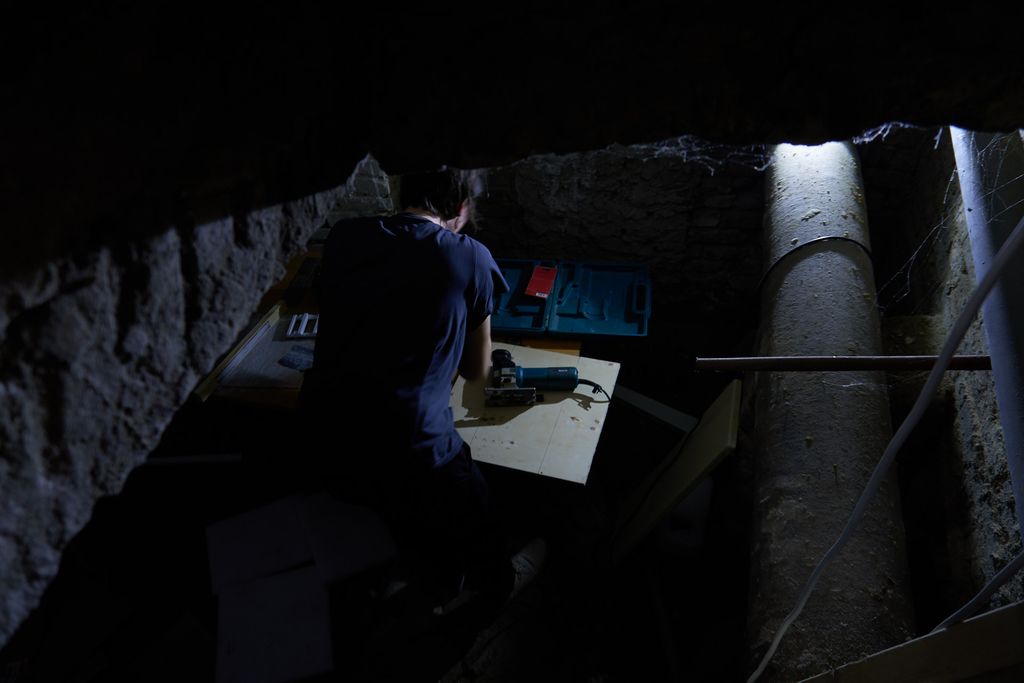From hand-milled housing and sandwich ovens to Grid 2.0
Deliver products. This has been our go-to strategy with Grid after the first prototypes showed great promise. Starting a hardware focused business is no easy task.
That's something we had to learn, but the available prototyping - in our case: small scale manufacturing - technologies for such a small modular product were a good fit. We were able to quickly iterate on printed circuit boards, front panels, bushings for potentiometers, module housing and all the related assemblies day after day. Our motto was to produce the best possible products given the scale and along the way figure out what works and what not.
With this mindset, we shipped our first Grid modules in 2020 March. Those units were rough. Each one of the controller housing was milled by hand. The CNC mill was built into a desk we found in a garage.

We had to hide this "device" in the cellar, so we weren't disturbing the neighbours too much with the noise in the evenings. Anyways, it helped us get started with shipping our first working units.
Another hardcore tool in our office was a repurposed sandwich oven. With the help of an Arduino, heat measurement code and a small control script, this black box became a fully fledged printed circuit reflow oven.
The stench was over the top, but after a couple of totally wasted attempts, this tool had served us well for the first hundred units or so. A while after we realized that the reflow oven and hand milling process had to go: results were hard to replicate, quality assurance was a nightmare. We made changes to how the circuit board components are placed, to make assembly easier. The build was also partially outsourced, some of the panels started to be built with proper manufacturing processes.
Going forward, we tweaked each circuit panel to get a consistent build quality and to keep only the necessary build steps in-house.
While the circuit boards were on their way to us, the quality of the module housing improved as well. We invested in higher quality resin 3D printers and built the best open hardware DIY CNC router we could find from parts across the web. We also built two large shelves as a manufacturing booth with an industrial fume extractor and protective plexiglass hood. Parts of the CNC router had to be switched around, but basically we used this setup of practices and machines to output 120 controllers per month. There were a lot of scrapped parts and it was a headache maintaining these devices. Despite all this, we still thought it was the right decision. These technologies helped us to continuously iterate based on the feedback we received from customers.

In 2022, chip supply chain issues hit the world and it impacted us as well.
We had to change the microcontroller used for our product line to ESP, as the previously used Atmel SAMD chips simply became unavailable. We still wanted to continue supporting older Grid units, while working on the transition, which started in the summer of 2022. The previously mentioned continuous manufacturing updates, internal design renewals and component changes spiced with this microcontroller transition became a monumentally complex task. There were just too many moving variables. We had to reach a point where Grid could be manufactured and developed consistently to put up with the increasing demand and quality expectations.
This year, we wanted to complete the redesign of Grid to be easily manufactured and assembled at a larger scale. Had to put together those moving parts and get the injection molded module housing done - iterations had to come to an end.
In the case of Grid, when the housing mold is ready, it becomes the base of the whole product line. All the smaller improvements must work within the boundaries set by the housing. Step by step, things started to move towards completion – although slower than planned – we have learnt a lot while making these changes, such as….
- To avoid glue , unnecessary connectors, choose press fit or screw driving where applicable. This resulted in a repairable design, where with the help of a screwdriver, following a short guide repairs can be done at home by the user.
- Redesign all module motherboards to use the new MCU while keeping compatibility with older Grid modules.
- Redesign the interface-boards to fit the injection molded shell and make the connectors larger granting it more surface area ensuring easier module snapping action.
- Get the injection molded housing.
- Remove the logo from the top panel to get a cleaner look and support new module ideas and rotation.
Completing these tasks, we can proudly say that Grid is now finally in the 2.0 state we imagined. The final injection molded housing came together nicely, all the small parts fit together as they should.
We look forward to whatever tomorrow brings, as the hardware feels decent now and we can continue developing more tools for the creative community.